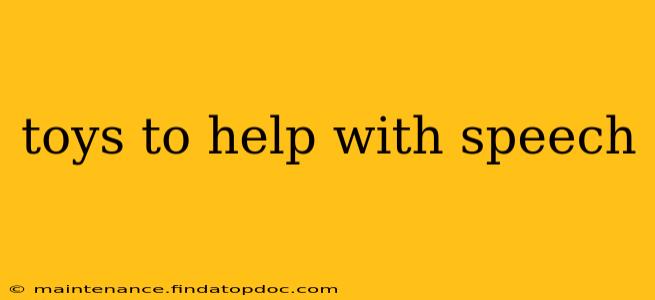Helping your child develop strong speech and language skills is a rewarding journey. While professional guidance from a speech-language pathologist (SLP) is invaluable, incorporating engaging toys into playtime can significantly boost progress. This guide explores a range of toys designed to stimulate speech development, categorized for easy navigation. Remember, consistency and playful interaction are key to maximizing the benefits.
What Makes a Toy Good for Speech Development?
Before we dive into specific toys, let's understand the characteristics of effective speech-development toys. Ideally, they should:
- Encourage Interaction: Toys that require back-and-forth communication, like turn-taking games, are excellent for developing conversational skills.
- Stimulate Language: They should prompt your child to use words, phrases, and sentences to express themselves, describe actions, or ask questions.
- Be Age-Appropriate: The complexity of the toy should match your child's developmental stage. A toy that's too easy will be boring, while one that's too difficult can be frustrating.
- Be Fun and Engaging: Learning should be enjoyable! Choose toys that your child genuinely loves to play with.
Types of Toys to Help with Speech Development
Here's a breakdown of different toy categories and their benefits for speech development:
1. Puzzles and Building Blocks:
These encourage problem-solving, vocabulary expansion (describing shapes, colors, sizes), and sequencing skills. Look for puzzles with clear pictures or simple words, and building blocks that can create stories or structures, prompting your child to narrate their creations.
2. Singing and Musical Toys:
Music is incredibly beneficial for language development. Singing songs together, playing musical instruments, and listening to music with lyrics help with rhythm, intonation, and vocabulary acquisition. Rhyming songs are especially helpful for phonological awareness.
3. Role-Playing Toys and Figurines:
Dolls, action figures, and play kitchens encourage imaginative play, narrative skills, and social interaction. As you play together, narrate the actions of the figures, ask questions about the story, and encourage your child to do the same.
4. Picture Books and Flash Cards:
Reading aloud together is crucial for vocabulary development, improving listening skills, and fostering a love of language. Interactive picture books with simple stories and repetitive phrases are ideal. Flash cards can help with vocabulary building and identifying objects.
5. Simple Board Games:
Games involving simple rules and turn-taking, like Candy Land or Chutes and Ladders, encourage communication, following directions, and using language to express their turns and actions.
6. Cause-and-Effect Toys:
These toys teach about sequences and relationships. Stacking toys, shape sorters, and simple mechanisms that produce sound or movement help children understand cause and effect and develop vocabulary related to these concepts.
7. Articulation Toys:
Some toys are specifically designed to target speech sounds. These might include toys with tongue twisters or those that emphasize certain sounds through repetition. These are best used in conjunction with an SLP's recommendations.
What if My Child is Having Trouble with Speech?
How can I tell if my child needs a speech therapist? This is a crucial question. Several signs might indicate the need for professional help, including delayed speech development, difficulty understanding language, limited vocabulary, or articulation problems. If you have concerns, consult your pediatrician or a speech-language pathologist. Early intervention is key for optimal outcomes.
Toys are Just One Piece of the Puzzle
Remember, toys are just one aspect of fostering speech development. Consistent, engaging interaction with your child, reading aloud regularly, and creating a language-rich environment at home are all equally crucial for their linguistic growth. Combine these strategies with the right toys, and you’ll be well on your way to supporting your child’s speech journey.
